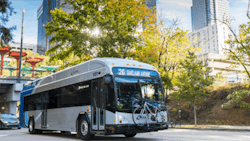VIA Metropolitan Transit, CATS to improve transit service with updated service plans
VIA Metropolitan Transit (VIA) and Charlotte Area Transit System (CATS) are set to improve transit service on their respective systems through the implementation of updated service plans.
VIA Board approves Better Bus Plan
VIA’s Board of Trustees approved the agency’s Better Bus Plan, a comprehensive initiative that will bring more frequent and reliable service to the region over the next several years. The system plan focuses on improving the VIA network by increasing frequency and reliability while implementing additional innovative transit solutions.
“We’ve done the planning, and now we’re moving forward with implementation,” said VIA President and CEO Jon Gary Herrera. “We know that better transit service not only gives back time to riders for what matters, but also attracts more riders and spurs economic growth across our region. As our community grows, it’s critical that we deliver a transit system that reflects the needs of our community today and tomorrow.”
Key improvements include the implementation of the VIA Rapid Green and Silver lines, system-wide frequency of 30 minutes or better with more frequent service on key corridors and an expansion of the VIA Link service in the region.
The agency says the Better Bus Plan was developed with input from the community and stakeholders through meetings, surveys and online feedback, such as maintaining existing routes, expanding VIA Link service and improved frequency and reliability.
The frequency improvements implemented by the agency on April 14 were the first phase of enhancements under the Better Bus Plan. The agency notes the second phase, which includes the proposed service improvements for August, builds on those earlier changes and further enhances service on several routes.
According to the agency, when evaluating routes for increased frequency opportunities, it considers post-pandemic travel patterns, operator availability, requests from the public and potential for maximum positive ridership impact. VIA will hold a series of public hearings in which the agency will provide more information on these improvements and gather community feedback to ensure the initiatives meet rider needs.
CATS ready to implement updated Transit System Plan (TSP)
CATS’ governing body, the Metropolitan Transit Commission (MTC), voted to adopt the updated TSP at its regularly scheduled meeting. The updated plan includes the prioritization of the Better Bus program, inclusive of microtransit, along with phased implementation of the rapid transit corridors. CATS says the plan represents a major transit expansion serving the Charlotte, N.C., region, including a 50 percent increase in bus service and 43 more miles of rail services.
According to CATS, the decision to approve this plan comes after nearly half a year of extensive public engagement with stakeholders, residents and riders across Mecklenburg County, N.C. Four scenarios were developed and presented to the public that included the Better Bus program, Red Line and Gold Line extension, but varied in the mode and length of the Silver Line corridor and the Blue Line extension corridor.
“Through our surveys, 93 percent of participants indicated that more transit options are needed in Mecklenburg County and the time to act is now,” said CATS Interim CEO Brent Cagle. “They also highlighted the need for increased frequency and connections to jobs, housing, education and daily destinations. We believe this updated plan meets the needs shared by our communities, and we applaud the MTC for their continued diligence and support of the communities that we serve.”
MTC Chair and Charlotte Mayor Vi Lyles added, “Today’s vote by the Metropolitan Transit Commission to adopt a unified transit system plan is an important milestone in our shared vision for the future of mobility in Mecklenburg County. This plan reflects years of collaboration, community input and a deep commitment to building a more connected, prosperous, accessible and sustainable region for generations to come. This is an important step to executing the vision we’ve worked so hard to shape and will serve residents across Charlotte and Mecklenburg County. The future of our transit system is not just about buses, microtransit and rail lines. It’s about connecting our communities, creating economic opportunity and helping everyone who lives in our community have a better quality of life.”
CATS notes the priority of the Better Bus plan is one of the key parts of the TSP, and most of the program will be implemented in the next five to 10 years. Riders can expect to see improved amenities, better frequency and additional microtransit zones within that period.
According to CATS, the other key to the updated TSP is the phased implementation of rail through the Rapid Transit Corridor System, including commuter rail, light rail and streetcar projects to provide reliable, time-competitive travel to connect people to housing, jobs, educational opportunities, shopping and entertainment.
The Rapid Transit Corridor System plan includes:
- Red Line commuter rail from Charlotte Gateway Station to Mount Mourne.
- Silver Line light rail from Airport to Coliseum/Ovens.
- Gold Line streetcar extension from Rosa Parks Place to Eastland.
- Blue Line light-rail extension from I-485/South Boulevard to Carolina Place Mall (Pineville).
- Future light-rail extensions for Silver Line west to I-485 and east to Matthews and Blue Line to Ballantyne, as funding allows, with enhanced bus in the interim.
About the Author
Brandon Lewis
Associate Editor
Brandon Lewis is a recent graduate of Kent State University with a bachelor’s degree in journalism. Lewis is a former freelance editorial assistant at Vehicle Service Pros in Endeavor Business Media’s Vehicle Repair Group. Lewis brings his knowledge of web managing, copyediting and SEO practices to Mass Transit magazine as an associate editor. He is also a co-host of the Infrastructure Technology Podcast.

